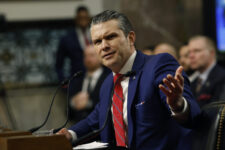 [updated Wednesday 12/5] WASHINGTON: Top executives from four major defense and aerospace firms sent a message to Congress and the Obama administration today: the nation expects its elected leaders to lead and the well-paid executives are willing to accept higher personal and corporate taxes on the path to find a solution to the nation’s fiscal woes. On top of that, they conceded that the Pentagon budget must be cut even more deeply than the $487 billion already targeted over the next decade to seal an increasingly elusive deal to stop the automatic spending cuts known as sequestration.
[updated Wednesday 12/5] WASHINGTON: Top executives from four major defense and aerospace firms sent a message to Congress and the Obama administration today: the nation expects its elected leaders to lead and the well-paid executives are willing to accept higher personal and corporate taxes on the path to find a solution to the nation’s fiscal woes. On top of that, they conceded that the Pentagon budget must be cut even more deeply than the $487 billion already targeted over the next decade to seal an increasingly elusive deal to stop the automatic spending cuts known as sequestration.
David Langstaff, CEO of an engineering and analysis services company called TASC, issued the strongest call for additional defense cuts. Those who have benefited from past national spending “should be willing to sacrifice,” he said. That means tax increases, bitterly opposed by most Republicans, and “reform,” which usually means the kinds of cuts to the big entitlement programs like Social Security and Medicare that most Democrats refuse to discuss.
Pressed to get specific on budget cuts, Northrop Grumman CEO Wes Bush suggested a tiny additional $20 billion to $25 billion over 10 years (on top of the $487 billion already cut by last year’s Budget Control Act). But Langstaff suggested $150 billion over the next decade.
Invoking the mantra of the now-retired Chairman of the Joint Chiefs of Staff, Adm. Mike Mullen, Langstaff declared that the greatest threat to national security was the federal debt, not any foreign foe. To defeat that threat, Langstaff went on, those who have benefited from past federal spending — such as himself — “should be willing to sacrifice.”
[Updated 12/5: It’s worth quoting Langstaff’s remarkable statement at greater length: “[Defense industry executives] are talking a good game, but are still unwilling to park short-term self-interest…. Every trade group, special interest and corporate lobbyist is up on Capitol Hill clamoring that Congress solve the problem, avoid the fiscal cliff and not default to sequestration…’but don’t touch my budgets!’ We can’t have it both ways…we need to stop pretending there’s a scenario out there that offers no defense cuts.”]
While it’s remarkable for the defense industry to propose defense cuts, Langstaff’s proposed $15 billion per annum reduction is still a much smaller percentage of the defense budget than was trimmed in past post-war drawdowns. And it’s nowhere near enough, according to a trio of good-government groups who convened a conference call this afternoon explicitly to rebut the quartet CEOs.
“When he said the $150 billion figure, I honestly cringed,” said Ben Freeman of POGO, the Project on Government Oversight, a persistent and respected critic of defense programs. Across DoD’s $600 billion budget, “that’s less than the amount of inflation,” Freeman scoffed. “We can get $15 billion from [cuts to] individual programs.”
“He’s playing defense,” punned Bill Hartung of the dovish Center for International Policy. “He’s trying to keep that number as small as possible.”
But the pro-defense cut camp smells blood in the water. “The public isn’t falling for this scare campaign,” sneered Christopher Preble of the libertarian Cato Institute. Preble took time to mock the Aerospace Industries Association, which organized this morning’s four-CEO panel as part of a massive campaign to stop sequestration, for investing heavily in a stop-sequestration campaign that has “backfired” and whose studies of the potential economic damage — up to 2 million jobs, by AIA’s count — have been “thoroughly discredited.”
POGO’s Freeman added that the “save jobs by stopping defense cuts” argument overlooks the fact that defense firms have already “cut thousands of jobs” even as revenues rose steeply in recent years. And he derided the industry overall, saying “it’s not very good at delivering jobs or delivering weapons…From the Joint Strike Fighter to the LCS [Littoral Combat Ship], lots of things are over budget, under-performing, and delayed.”
“I’m more hopeful than some that we will get some Pentagon cuts,” Freeman went on. The current fiscal cliff negotiations are “a three-way heavyweight fight,” he said, in which tax hikes and entitlement cuts are far more politically difficult than cutting defense.
Besides, Freeman and his cohorts said, Pentagon spending cuts — even at sequestration levels — would not be immediately painful for the defense industry, anyway. Although the AIA and its allies in Congress have kept the spotlight on weapons programs, those accounts are fairly well insulated from sequestration’s effects, because most procurement and R&D funding is not spent until a year or more after Congress appropriates it.
“Many of the companies have large backlogs, [and] the Pentagon has $100 billion in unobligated dollars” — money already appropriated but for which no contract has been signed — said Hartung: “There’s no fiscal cliff for the Pentagon. It’s more of a gradual slope.”
That said, Hartung went on, “sequestration is bad management.” The law would blindly, mindlessly, automatically cut almost all federal programs — with a few exceptions such as military pay — by almost exactly equal amounts: 9.4 percent for non-exempt defense programs and 8.4 percent for non-defense, according to estimates by the president’s Office of Management and Budget.
What’s worse, although the impact on procurement and R&D programs would be delayed, the damage to other areas would be immediate. Federal grant programs and aid to state and local governments would have to slash their spending immediately, which means layoffs of teachers, police, and the like, said Hartung.
Also immediate would be the impact on federal workers, both at the Pentagon and at civilian agencies. Since laying off a civil servant actually costs more in the short run than it saves — especially, Freeman noted, if they’re then replaced by outside contractors — the federal government would have to save on payroll by ordering employees on unpaid leave instead.
But no federal employee can be furloughed this way for more than 22 work days a year. Assuming every agency furloughs every single employee for that maximum amount of time, that still only saves 22 days out of the (on average) 261 work days in the year: 8.43 percent, just barely enough to meet the sequestration mandate of 8.40 percent for non-defense agencies. So if an agency deems any of its employees too essential to furlough — like air traffic controllers, for example, cybersecurity experts, or intelligence analysts — it may not actually be able to implement sequestration without breaking federal law.
Hegseth fires Navy’s top officer, Air Force No. 2
The firings of Adm. Lisa Franchetti and Gen. James Slife follows tonight’s removal of Gen. CQ Brown as chairman of the Joint Chiefs of Staff.


























